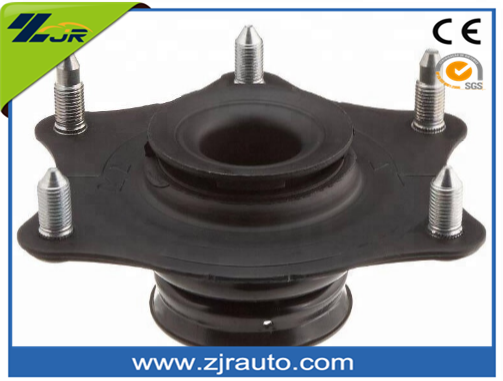Views: 1 Author: Site Editor Publish Time: 2025-09-11 Origin: Site








When it comes to vehicle maintenance, understanding your car's suspension system is crucial. One key component in this system is the strut mount. For anyone interested in car parts and auto spare parts, knowing about strut mounts, how they function, and how to replace them can save both money and potential safety hazards. This article explores everything you need to know about strut mounts, including their role, types, and replacement process.
A strut mount is an essential component of a car’s suspension system. It connects the vehicle’s strut assembly to the chassis and acts as a buffer to absorb road shocks, vibrations, and noise. Strut mounts play a dual role: they secure the strut in place and provide cushioning to enhance driving comfort and safety.


Standard Strut Mounts: Used in most vehicles with conventional struts, providing basic damping and connection.
Strut Mounts with Bearing: Common in vehicles with front-wheel steering, these mounts allow the strut to pivot when turning, ensuring smooth steering performance.
The quality of your strut mounting directly affects vehicle handling, ride comfort, and tire wear. Ignoring worn-out mounts can lead to noises like clunking or squeaking and even suspension misalignment.
Before diving deeper into strut mounts, it’s essential to understand struts. A strut is a type of suspension component that integrates a shock absorber and a coil spring into a single unit. Struts support the weight of the vehicle, maintain wheel alignment, and provide stability during driving.
The strut mount complements the strut by securing it to the vehicle’s body and absorbing road vibrations. Together, struts and mounts form a critical part of the suspension system, ensuring:
Smooth and stable ride quality
Improved handling during turns and braking
Reduced stress on other suspension components
| Component | Function | Importance | Signs of Wear |
|---|---|---|---|
| Strut | Absorbs shocks, supports vehicle weight | Essential for ride comfort | Bouncing, poor handling |
| Strut Mount | Connects strut to chassis, absorbs vibration | Ensures smooth steering and reduces noise | Clunking, squeaking, steering vibration |
By understanding the difference between struts and strut mounts, car owners can better diagnose issues and make informed decisions regarding auto spare parts replacements.
Replacing a strut mount requires mechanical skill and the right tools. Here is a step-by-step guide:
Socket and ratchet set
Spring compressor
Jack and jack stands
Torque wrench
Safety First: Ensure the vehicle is on a flat surface and use jack stands for stability. Never work under a car supported only by a jack.
Remove the Wheel: Loosen the lug nuts, lift the vehicle with a jack, and remove the wheel to access the strut assembly.
Disconnect Components: Remove any parts obstructing the strut, including brake lines or sway bar links.
Remove the Strut Assembly: Unbolt the strut from the chassis and suspension. Use a spring compressor to safely remove tension from the coil spring.
Replace the Strut Mount: Remove the old strut mount and install the new one. Ensure it is oriented correctly and seated securely.
Reassemble the Strut Assembly: Reattach the strut to the vehicle, reconnect all components, and torque bolts to manufacturer specifications.
Check Alignment: After replacing strut mounts, it’s recommended to get a wheel alignment to ensure proper handling and tire wear.
Replacing a strut mount may seem complex, but with careful attention to detail and proper tools, it can be completed by experienced DIY enthusiasts.


Knowing when to replace your strut mounts can prevent more severe suspension problems. Common signs include:
Clunking or knocking noises when driving over bumps
Excessive vibration in the steering wheel
Uneven tire wear
Vehicle leaning to one side
Ignoring these symptoms can lead to reduced vehicle stability and increased risk of accidents.
A strut mount is the component that connects the strut assembly to the vehicle chassis, providing both support and cushioning for road vibrations.
Struts are suspension units combining a shock absorber and coil spring, while strut mounts secure these struts to the vehicle and help absorb road shocks.
Replacing a strut mount involves removing the strut assembly, safely compressing the coil spring, swapping the old mount with a new one, and reassembling the strut while ensuring all bolts are torqued to specification.
Strut mounts generally last 50,000–100,000 km, but this can vary based on driving conditions and vehicle type.
Yes, if you have the right tools, mechanical knowledge, and safety precautions. However, professional installation is recommended for beginners to ensure vehicle safety.
Inspect strut mounts during routine suspension checks
Replace mounts at the first sign of wear or noise
Avoid aggressive driving on rough terrain to prolong mount life
Ensure professional alignment after replacement
High-quality car parts like strut mounts and related auto spare parts are crucial for vehicle safety and performance. Substandard components can lead to:
Premature wear of suspension parts
Increased noise and vibration
Reduced vehicle stability
Investing in reliable brands ensures durability, smoother rides, and fewer repairs.


For premium strut mounting solutions and other essential auto spare parts, ZJR Auto is a trusted choice. Their products are engineered for quality, durability, and performance, making them perfect for DIY enthusiasts and professional mechanics alike.
Email: info@zjrauto.com
Phone: +86 13702583315
With ZJR Auto, you can ensure your car’s suspension system remains in top condition, providing comfort and safety on every journey.
Understanding strut mounts, their role, and how to replace them is critical for vehicle maintenance. By investing in high-quality car parts and auto spare parts, such as those offered by ZJR Auto, you can maintain your car’s performance, safety, and longevity. Regular inspection and timely replacement of strut mounts will ensure a smooth and reliable driving experience for years to come.